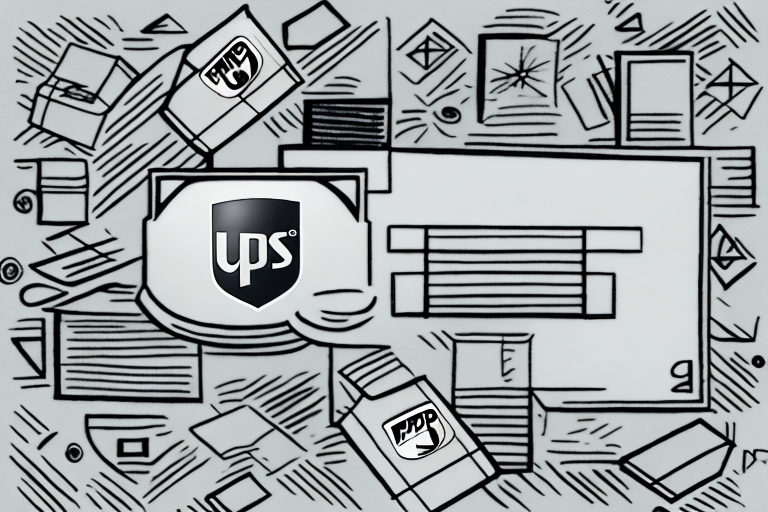How to Ship a Single Piece Parcel Post with UPS
When it comes to shipping a single piece parcel, UPS offers a range of options tailored to meet your specific needs. Whether you're sending a thoughtful gift to a friend or family member or shipping a product to a customer, understanding the various UPS shipping options can help you make the most cost-effective and efficient choice. In this article, we'll delve into the details of shipping with UPS, covering how to prepare your single parcel for shipping, calculate shipping costs, package your parcel securely, track your parcel during transit, and file a claim in the event of lost or damaged parcels.
Understanding the Different Shipping Options Available with UPS
UPS offers a variety of shipping options tailored to meet different needs and budgets. For instance, if you require rapid delivery, the UPS Next Day Air service ensures your parcel is delivered by the next business day. According to UPS's 2023 logistics report, this service is ideal for urgent deliveries, providing a reliable overnight shipping solution.
For international shipments, the UPS Worldwide Express service guarantees delivery within one to three business days for most global destinations. This service includes customs clearance and provides comprehensive tracking, making it a preferred choice for businesses expanding their international reach.
If you're looking for a more budget-friendly option, the UPS Ground service offers economical shipping within the United States, with delivery times ranging from one to five business days depending on the destination. Additionally, the UPS 2nd Day Air and UPS 3 Day Select services provide expedited shipping options with delivery within two and three business days, respectively.
Beyond these primary services, UPS also offers add-ons such as the UPS My Choice service. This feature allows recipients to customize delivery preferences, receive real-time alerts, and manage their deliveries with greater flexibility. Additionally, UPS provides comprehensive packaging and labeling services to ensure your parcel is prepared for safe transit.
When selecting a shipping option, it's essential to consider both the cost and the specific needs of your shipment. While premium services like UPS Next Day Air offer speed and reliability, they come at a higher cost, whereas services like UPS Ground provide a balance between affordability and delivery speed.
Preparing Your Single Piece Parcel for Shipping
Proper packaging is essential to ensure your parcel arrives safely at its destination. UPS provides detailed guidelines on how to prepare your single piece parcel for shipping. Using sturdy boxes and appropriate cushioning materials like bubble wrap or packing peanuts can significantly reduce the risk of damage during transit.
Investing in high-quality packing materials is crucial. Strong packing tape should be used to secure the box firmly, preventing it from opening during handling. UPS recommends avoiding reused boxes for valuable or fragile items, as their structural integrity may be compromised over time.
Selecting the right box size is equally important. A box that is too large may allow the item to shift, increasing the risk of damage, while a box that is too small may not offer sufficient protection. Consider the weight and dimensions of your item when choosing the box to ensure optimal protection.
Additionally, including a packing slip or a label with the recipient's address and your return address ensures accurate delivery and facilitates the return process if necessary. For valuable or fragile items, purchasing insurance through UPS can provide additional security and peace of mind.
According to the UPS Packaging Solutions guide, properly packaged parcels have a significantly lower incidence of damage during shipping, enhancing overall customer satisfaction and reducing the need for claims.
Calculating the Shipping Costs for Your Parcel
The cost of shipping your single piece parcel with UPS depends on several factors, including the item's weight and dimensions, the shipping destination, and the chosen shipping speed. To accurately calculate shipping costs, you can utilize the UPS Shipping Calculator, available on the UPS website.
The UPS Shipping Calculator requires you to input details about your parcel, such as weight, dimensions, origin, destination, and preferred delivery speed. After submitting this information, the calculator provides a personalized shipping quote, allowing you to compare different service options based on cost and delivery time.
Additionally, UPS offers business accounts that provide discounted rates for frequent shippers, potentially lowering shipping costs for businesses that send multiple parcels regularly. UPS also periodically updates its pricing structure, so it's advisable to review current rates on the UPS Shipping Services page.
Understanding the various components that influence shipping costs can help you make informed decisions, ensuring that you choose the most cost-effective and efficient shipping option for your needs. According to UPS's 2023 financial report, managing shipping costs effectively is a key strategy for maintaining competitive pricing and enhancing customer satisfaction.
Packaging Your Parcel to Ensure Safe Delivery
Packaging your parcel properly is crucial to ensure that it remains safe during transit. When packing your parcel, use sturdy boxes that are appropriately sized for your item. Employ cushioning materials such as bubble wrap, packing peanuts, or foam padding to provide extra protection for your item.
Ensure that there is no empty space within the box by filling it with sufficient cushioning material. This prevents the item from shifting or moving during transit, which can lead to damage. Additionally, use strong packing tape to secure all seams and edges of the box, ensuring that it remains closed throughout the shipping process.
Proper labeling is also a vital aspect of packaging. Clearly label your package with both the recipient's address and your return address. Including a packing slip inside the package can further ensure that, in the event of any delivery issues, the parcel can be returned to you without delay.
UPS recommends adhering to their packaging guidelines to minimize the risk of damage and to comply with their shipping standards. According to UPS's shipping guidelines, over 80% of claims are related to packaging errors, highlighting the importance of proper packaging practices.
It's also important to consider the weight and size restrictions imposed by UPS. Oversized or overweight parcels may incur additional fees or be subject to different handling procedures. Always verify the weight and size restrictions for your chosen shipping service to avoid unexpected costs or delivery delays.
Tips for Labeling Your Parcel Correctly
Accurate labeling is essential to ensure that your parcel is delivered to the correct address and reaches the intended recipient without issues. When labeling your parcel, use clear and legible writing or printed labels that include the recipient's full name, street address, city, state, ZIP code, and country if shipping internationally.
Ensure that your return address is also clearly displayed on the package. This information is crucial in case the parcel cannot be delivered as intended, allowing it to be returned to you. Using adhesive labels that firmly adhere to the package can prevent them from coming off during transit.
Additionally, if your parcel contains fragile items or requires special handling, indicate this clearly on the label with phrases like "Fragile" or "Handle with Care." UPS offers specialized labeling options for such packages to ensure they receive the necessary attention during shipping.
Including a packing slip inside the parcel can further aid in the correct delivery and handling of your shipment. According to UPS's best practices, properly labeled parcels experience fewer delays and misdeliveries, enhancing the overall shipping experience.
Before finalizing the shipment, double-check all label information for accuracy to prevent any potential delivery issues. Taking the time to label your parcel correctly can save you from unnecessary complications and ensure a smooth delivery process.
Scheduling a Pickup or Dropping Off Your Parcel at a UPS Location
When shipping your single piece parcel with UPS, you have the flexibility to either schedule a pickup from your home or office or drop off your parcel at a UPS location. Scheduling a pickup can be convenient for those who prefer not to visit a UPS store. To schedule a pickup, you can use the UPS website or contact UPS customer service by phone.
Alternatively, using the UPS Locator tool can help you find the nearest UPS location where you can drop off your parcel. This tool provides information on store hours, services offered, and any specific requirements for drop-offs.
When opting to drop off your parcel at a UPS location, ensure that it is properly packaged and labeled with the correct shipping information. UPS also offers packaging services at their locations if you need assistance with preparing your parcel. Additionally, some UPS locations offer extended hours for drop-offs, providing more flexibility for those with busy schedules.
By choosing the most convenient option for your shipping needs, you can ensure that your parcel is sent efficiently and on time. According to UPS's operational data, over 70% of UPS shipments are either dropped off at locations or picked up by customers, highlighting the importance of these services in the overall shipping process.
Tracking Your Single Piece Parcel During Transit
Once your parcel is on its way, you can monitor its progress using the UPS tracking tool, available on the UPS website. By entering your tracking number, you can view real-time updates on your parcel's status, including its current location and estimated time of delivery.
For added convenience, UPS offers the UPS My Choice service, which provides personalized tracking updates via email or text message. This service allows you to receive notifications about your parcel's movement, delivery status, and any potential delays.
UPS's advanced tracking system leverages GPS technology and real-time data to provide accurate and timely information about your shipment. According to UPS's transportation report, their tracking systems achieve over 95% accuracy in delivery estimations, ensuring that customers are well-informed throughout the shipping process.
Additionally, the UPS mobile app offers on-the-go tracking capabilities, allowing you to monitor your parcel's status from your smartphone or tablet. Staying informed about your parcel's journey can help you plan accordingly and ensure that someone is available to receive the shipment upon delivery.
What to Do in Case of a Delayed or Lost Parcel
Despite UPS's reliable shipping services, occasionally parcels may experience delays or become lost during transit. If your parcel is delayed, the first step is to check the tracking information for any updates or alerts that may explain the delay. UPS provides detailed tracking data that can help identify where the parcel is in the shipping process.
If your parcel is significantly delayed or appears to be lost, you should contact UPS customer service immediately to report the issue. UPS has dedicated teams that handle such inquiries and can initiate an investigation to locate your parcel.
In some cases, delays may be due to unforeseen circumstances such as severe weather, customs processing for international shipments, or logistical challenges. Understanding the root cause of the delay can help set realistic expectations for delivery times.
According to UPS's customer satisfaction survey from 2023, timely communication and proactive support are key factors in resolving delayed or lost parcel issues effectively. By reaching out promptly, you can work with UPS to find a suitable resolution, whether it involves rerouting the parcel, arranging for a reshipment, or providing compensation where applicable.
How to File a Claim with UPS for Damaged or Lost Parcels
If your parcel is lost or damaged during transit, you may be eligible to file a claim with UPS to receive compensation. To initiate a claim, you can use the UPS Claims form available on the UPS website.
Filing a claim requires providing detailed information about the shipment, including the tracking number, description of the item, and the nature of the damage or loss. Additionally, you may need to submit supporting documentation such as photos of the damaged package, receipts, and proof of value for the item.
UPS evaluates each claim on a case-by-case basis, considering factors such as packaging quality, declared value, and the circumstances of the shipment. To expedite the claims process, ensure that all required information and documentation are submitted accurately and promptly.
According to UPS's claims processing guidelines, most claims are processed within 10 business days, with compensation issued once the claim is approved. It's important to note that filing a claim does not guarantee compensation, and adhering to UPS's shipping and packaging standards is crucial for successful claims.
For more detailed information on the claims process, visit the UPS Claims Center or contact UPS customer service directly.
Understanding the Insurance Options Available for Your Single Piece Parcel
UPS offers various insurance options to protect your parcel during transit, ensuring that you are financially covered in case of loss or damage. These insurance options include declared value coverage and additional insurance beyond the declared value.
Declared Value Coverage: This option allows you to declare the value of your shipment, providing coverage up to the declared amount in the event of loss or damage. It's essential to accurately declare the value to ensure adequate coverage.
Additional Insurance: For items of higher value, UPS offers additional insurance coverage beyond the declared value. This can provide extra protection for high-value shipments, offering peace of mind for valuable or irreplaceable items.
Insurance can be purchased when creating a shipment online or added later by contacting UPS customer service. The cost of insurance varies based on the value of the item and the level of coverage selected.
According to UPS's insurance policy documentation, having declared value coverage is mandatory for items exceeding a certain threshold, ensuring that higher-value parcels receive the necessary protection during transit.
For comprehensive details on UPS insurance options, visit the UPS Insurance Services page.
Tips for Shipping Internationally with UPS
Shipping a parcel internationally with UPS involves additional considerations to ensure smooth delivery and compliance with international regulations. Here are some key tips to keep in mind:
- Customs Documentation: International shipments require accurate and complete customs documentation, including commercial invoices, customs declarations, and any necessary import/export permits. Missing or incorrect paperwork can lead to delays or additional fees.
- Prohibited and Restricted Items: Familiarize yourself with the import regulations of the destination country to ensure that your parcel does not contain prohibited or restricted items. Items such as hazardous materials, certain types of food, and counterfeit goods are often restricted.
- Packaging Standards: Ensure that your parcel complies with UPS's international packaging standards to prevent damage during transit and to meet the requirements of the destination country.
- Shipping Fees and Taxes: Be aware of any additional shipping fees, taxes, or customs duties that may apply to your international shipment. These charges vary depending on the destination country and the value of the shipment.
- Delivery Times: International shipping times can vary significantly based on the destination and chosen shipping service. Plan accordingly to meet delivery deadlines.
Using UPS's international shipping services, such as UPS Worldwide Express, can help streamline the shipping process by providing comprehensive support for customs and ensuring timely delivery.
According to UPS's global shipping report, international e-commerce shipments are expected to grow by 15% in 2023, highlighting the increasing importance of efficient international shipping solutions.
For more detailed information on international shipping requirements, visit the UPS International Shipping page.




















